Keep the Tail Wagging is supported by pet parents. I occasionally earn a commission (at no additional cost to you) when you click through an affiliate link to one of my favorite products. Thank you for your support. Read More
Feeding your dog a homemade diet gives you full control over the quality, freshness, and variety of the ingredients in their bowl. Two standout proteins for rotation in a balanced homemade diet are pork and turkey necks (or wings). Together, they provide a rich array of nutrients, support joint health, and deliver the taste dogs love.
Here’s why pork and turkey necks are valuable additions to your dog’s diet — and what benefits they bring.
Pork: Highly Digestible & Nutrient-Rich
Pork is often overlooked in homemade feeding, but is an excellent, easily digestible protein source for dogs. It’s rich in essential amino acids and naturally higher in fat, making it a great energy source — especially for active dogs or those needing to maintain weight.
Key Nutrients in Pork:
- Protein – Supports muscle growth and repair.
- Thiamine (Vitamin B1) – Critical for carbohydrate metabolism, nerve function, and energy.
- Niacin (Vitamin B3) – Supports healthy skin, digestion, and energy production.
- Vitamin B6 – Aids in hormone regulation and nervous system function.
- Phosphorus & Zinc – Important for bones, immune function, and skin health.
- Selenium – An antioxidant that supports immune and thyroid function.
Bonus: Pork is a “cooling” protein in Traditional Chinese Medicine, helpful for dogs with inflammatory conditions or heat-related imbalances.
Turkey Necks: Bone Support & Natural Joint Boost
Turkey necks are one of the best whole food sources of calcium and phosphorus, offering natural balance for bone development and maintenance. They also provide glucosamine, chondroitin, and collagen — key players in joint health.
Key Nutrients in Turkey Necks:
- Calcium & Phosphorus – Essential for bone and dental health.
- Glucosamine & Chondroitin – Support cartilage repair and joint mobility.
- Collagen & Gelatin – Strengthen joints, ligaments, tendons, and skin.
- B Vitamins – Especially B6 and niacin for energy and metabolism.
- Protein – Additional high-quality protein for muscle health.
Plus, turkey necks, when fed whole, help promote dental hygiene through natural chewing action.
Thyroid Risk with Turkey Necks:
Some believe the risk of a dog developing hypothyroidism from eating raw poultry necks is low, but it’s still possible. That’s why sourcing matters. I buy from a local farm with strict safety practices.
When preparing raw necks, I check for a small, dark red to purplish piece of tissue near the top, likely thyroid tissue, which should be removed before feeding. So far, I’ve never found thyroid tissue in necks sourced through my local raw food co-op.
Why These Two Together?
Feeding pork and turkey necks together in a homemade diet provides:
- A complete range of essential amino acids
- Naturally balanced calcium-phosphorus ratios
- Powerful joint and mobility support
- Key B vitamins for energy, nerve, and metabolic function
- Nutrients that promote skin health, immune function, and healthy weight maintenance
A Few Feeding Tips:
- Always source pork from reputable suppliers and feed it fully cooked to reduce the risk of parasites (like trichinella).
- Turkey necks can be fed raw or gently cooked, depending on your dog’s tolerance and your comfort level.
- Balance the recipe with organs (like pork liver or kidney), and include other nutrient-rich foods (such as veggies, seeds, or supplements) to ensure full-spectrum nutrition.
Sourcing Ingredients for this Recipe
The ingredients for this recipe were sourced from a variety of trusted suppliers. I purchased the beef, turkey necks, and organ meats in bulk from a local raw food co-op. The sardines came from Oma’s Pride, while the chicken eggs were sourced from both a local homesteader and Costco. I obtained the sunflower and hemp seeds from Costco and Amazon. The kelp was sourced from Life Line Pet Nutrition, and the base mix was purchased from Dr. Harvey’s via Amazon.
- List of US raw food co-ops
- Oma’s Pride
- Sunflower Seeds
- Hemp Seeds
- Life Line Pet organic kelp
- Dr. Harvey’s Raw Vibrance
Homemade Raw Dog Food Recipe
This recipe was formulated using Animal Diet Formulator software for a healthy 55-pound dog without food sensitivities or other health issues. If you feed this recipe to a dog of a different weight, keep in mind that the nutrient breakdown will vary slightly. While it’s ideal to customize recipes for each dog, I feed this same recipe to all of my dogs, despite their varying weights, because I quickly ascertained in the software that the recipe remained balanced for each of my dogs, despite their different body weights.
Ingredients:
Animal Diet Formulator Software Report
| 1 | 2.23 lbs | raw ground pork |
| 2 | 17.50 lbs | ground turkey necks* |
| 3 | 3.03 lbs | pork liver |
| 4 | 1.00 lbs | pork kidneys |
| 5 | 3.25 lbs | whole, raw sardines |
| 6 | 4 | large chicken eggs |
| 7 | 4.0 oz | raw, unsalted sunflower seeds |
| 8 | 1.16 oz | organic ground kelp |
| 9 | 5.65 oz | organic hulled hempseeds |
| 10 | 8.0 oz | canned boiled oysters |
| 11 | 1.00 lb (2 cups) | Dr. Harvey's Raw Vibrance |
*If you prefer not to feed turkey necks, you can swap the turkey necks for 4.5 pounds of turkey wings and make the following changes to maintain a balanced diet for your dog.
- Reduce ground pork to 2.0 pounds.
- Reduce pork liver to 1.25 pounds.
- Reduce pork kidneys to 8 ounces.
- Reduce sardines to 1.25 pounds.
- Increase the number of large chicken eggs to 6.
- Reduce sunflower seeds to 1.0 ounce.
- Reduce ground kelp to 1.0 ounce.
- Reduce hempseeds to 5.6 ounces.
- Reduce canned oysters to 5.5 ounces.
- Add 3.44 ounces of mussels.
How Much to Feed My Dogs
The Animal Diet Formulator software will tell you how much to feed your dog based on calories. I use a raw feeding calculator and weigh my dogs' meals because this better accounts for their metabolism and daily or weekly exercise. I weigh my dogs twice monthly and adjust how much I feed based on their weight.
Homemade Dog Food Nutrient Breakdown
This recipe was formulated using Animal Diet Formulator software based on FEDIAF guidelines for a 55-pound dog. The nutrient profile includes macronutrients, vitamins, fats, and amino acids. For a detailed breakdown—including amino acid profiles, dry matter values, and daily intake figures—please refer to the Animal Diet Formulator report below:
Macro Nutrient Analysis
| As Formulated | %kcal | |
| Protein | 17.35% | 45.83% |
| Fat | 8.00% | 47.58% |
| Ash | 3.39% | |
| Moisture | 68.39% | |
| Dietary Fiber | 0.37% | |
| Soluable | ||
| Insoluable | ||
| Net Carbs | 2.49% | 6.59% |
| Sugars | .06% | .16% |
| Starch | 0.08% | 0.22% |
| Total | 100.00% |
Minerals – Units/1000 kcal
Ca – calcium, P – phosphorus, K – potassium, Na – sodium, Mg – Magnesium, Cl – chloride, Fe – iron, Cu – copper, Mn – manganese, Zn – zinc, I – , Se – selenium
| Unit | Minimum | Maximum | Recipe | |
| Ca | g | 1.45 | 6.25 | 5.76 |
| P | g | 1.16 | 4.00 | 3.66 |
| Ca:P | ratio | 1:1 | 2:1 | 1.57:1 |
| K | g | 1.45 | 2.07 | |
| Na | g | 0.29 | 1.17 | |
| Mg | g | 0.20 | 0.72 | |
| Cl | g | 0.43 | 0.43 | |
| Fe | mg | 10.40 | 170.00 | 28.87 |
| Cu | mg | 2.08 | 7.00 | 2.52 |
| Mn | mg | 1.67 | 42.50 | 1.93 |
| Zn | mg | 20.80 | 56.80 | 35.23 |
| I | mg | 0.30 | 2.75 | 1.55 |
| Se | mg | 0.09 | 0.24 |
Vitamins – Units/1000 kcal
| Unit | Minimum | Maximum | Recipe | |
| Vit A | IU | 1,754.00 | 100,000.00 | 20,348.57 |
| Vit C | mg | 20.62 | ||
| Vit D | IU | 159.0 | 568.00 | 220.31 |
| Vit E | IU | 10.40 | 41.22 | |
| Thiamine, B1 | mg | 0.62 | 0.91 | |
| Riboflavin, B2 | mg | 1.74 | 3.56 | |
| Niacin, B3 | mg | 4.74 | 30.52 | |
| Vit B5 | mg | 4.11 | 8.31 | |
| Vit B6 | mg | 0.42 | 2.31 | |
| Vit B12 | mg | 0.01 | 0.03 | |
| Folic Acid | mg | 0.08 | 0.19 | |
| Choline | mg | 474.00 | 475.50 | |
| Vit K1 | mg | 0.01 | ||
| Biotin | mg | 0.01 |
Fats – Units/1000 kcal
| Unit | Minimum | Maximum | Recipe | |
| Total | g | 13.75 | 52.867 | |
| Saturated | g | 13.563 | ||
| Monounsaturated | g | 15.279 | ||
| Polyunsaturated | g | 15.849 | ||
| LA | g | 3.82 | 13.011 | |
| ALA | g | 1.541 | ||
| AA | g | 0.586 | ||
| EPA | g | 0.163 | ||
| DPA | g | 0.097 | ||
| DHA | g | 0.396 | ||
| Omega 6 / Omega 3 | ratio | 6.19:1 | ||
| EPA + DHA | g | 0.559 |
Amino Acids – Units/1000 kcal
| Unit | Minimum | Maximum | Recipe | |
| Total protein | g | 52.1 | 114.573 | |
| Tryptophan | g | 0.49 | 1.339 | |
| Threonine | g | 1.51 | 4.731 | |
| Isoleucine | g | 1.33 | 4.731 | |
| Leucine | g | 2.37 | 8.775 | |
| Lysine | g | 1.22 | 9.416 | |
| Methionine | g | 1.16 | 2.992 | |
| M- Cystine | g | 2.21 | 4.33 | |
| Phenylalanine | g | 1.56 | 4.417 | |
| P – Tyrosine | g | 2.58 | 8.261 | |
| Valine | g | 1.71 | 5.344 | |
| Arginine | g | 1.51 | 7.283 | |
| Histidine | g | 0.67 | 3.299 | |
| Purines | mg | 479.829 | ||
| Taurine | g | 0.515 |
Disclaimer: I’m sharing this recipe to help pet parents explore what a balanced raw food diet can look like. While I’ve completed an online canine nutrition course, I am not a professional canine nutritionist and do not offer meal formulation or consulting services. This recipe is balanced for my own dogs, but it may not meet the needs of every dog if fed exclusively. If you’d like to learn more about formulating fresh food diets, I encourage you to take advanced online courses and consult with a qualified canine nutritionist—someone with formal education and hands-on experience beyond an introductory course.





